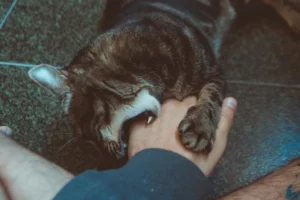Cats are beloved pets for many people, but sometimes they can exhibit unexpected behavior, such as attacking ankles. Have you ever wondered why cats do this? Let’s explore the reasons behind this common feline behavior.
Ankle-Biting: A Natural Instinct
Cats are predators by nature, with an innate drive to hunt and pounce on moving objects. This predatory instinct is deeply ingrained in their behavior, even when they are domesticated pets. When cats attack ankles, it’s often an expression of this hunting instinct translated into playful behavior. They see the movement of your feet as prey they can chase and capture.
Additionally, cats have a strong sense of curiosity and a need for stimulation. Ankle-biting can provide them with mental and physical exercise, simulating the thrill of the hunt. It’s important to understand that this behavior is usually not meant to be aggressive but rather a form of play for your feline friend.
Seeking Attention or Playtime
When your cat attacks your ankles, it could be their way of seeking attention or initiating playtime. Cats are social creatures that crave interaction with their human companions. By nipping at your ankles, they may be communicating their desire for play or simply trying to engage with you.
To discourage this behavior, make sure to provide adequate playtime and enrichment for your cat. Engage in interactive play sessions with toys that stimulate their hunting instincts. Providing scratching posts and climbing structures can also help redirect their playful energy. Remember, cats thrive on routine and stimulation, so establishing a consistent play schedule can help prevent ankle attacks.
Bonus Tip: Consider incorporating food puzzles or interactive feeders into your cat’s daily routine. This not only provides mental stimulation but also helps fulfill their hunting instincts in a positive way.
Boredom or Lack of Stimulation
Do you ever find your feline friend sneakily attacking your ankles out of nowhere? Well, one possible reason could be boredom or a lack of mental stimulation. Cats are curious creatures, and when they don’t have enough activities to keep them engaged, they may resort to ankle-biting as a way to entertain themselves. To prevent this behavior, provide interactive toys and regular play sessions to keep your furry companion mentally stimulated and happy.
Territorial Behavior
Have you ever wondered why your cat sees your ankles as a threat to their territory? Cats are naturally territorial animals, and they may view any movement in their space as a potential invasion. Ankle-biting could be their way of asserting dominance and protecting their territory. To address this behavior, create designated spaces for your cat to feel secure and avoid sudden movements that might trigger their territorial instincts. Remember, understanding your cat’s behavior is key to fostering a harmonious relationship with your beloved pet.
Redirected Aggression
When cats feel stressed or threatened by a situation, they may redirect their aggression towards unsuspecting ankles passing by. This behavior stems from their natural instincts to protect themselves in unfamiliar or tense environments. If your cat is lashing out at your ankles, consider what other factors could be causing their distress. Are there loud noises, new animals in the house, or changes in their routine? Identifying the source of their stress can help you address the root cause of their behavior and find solutions to alleviate their anxiety.
Training and Discouraging Ankle-Biting
If your cat has developed a habit of attacking your ankles, there are several strategies you can try to discourage this behavior. First, make sure your feline friend has plenty of toys and scratching posts to redirect their energy towards appropriate outlets. When your cat does go for your ankles, distract them with a loud noise or a gentle squirt of water from a spray bottle. Consistency is key in training your cat, so be patient and firm in correcting this behavior. Additionally, spend quality time playing with your cat to provide mental and physical stimulation, helping to reduce their urge to attack ankles.
Effective Techniques to Stop Ankle-Biting:
- Positive Reinforcement: Reward your cat with treats and praise when they play nicely and refrain from attacking ankles.
- Avoid Punishment: Never yell at or physically punish your cat for ankle-biting, as this can escalate their stress and anxiety.
- Consult a Professional: If your cat’s behavior persists despite your efforts, consider consulting a veterinarian or animal behaviorist for further guidance.
By understanding the reasons behind ankle-biting and using positive training techniques, you can help your cat overcome this behavior and create a harmonious living environment for both of you.
Providing Enrichment and Play Opportunities
Is your cat constantly going for ankles? It might be a sign that they need more mental and physical stimulation. Try engaging your feline friend in interactive play sessions using toys like laser pointers or feather wands to redirect their energy. Puzzle feeders or treat dispensing toys can also keep them mentally engaged. Additionally, setting up designated play areas in different parts of your home can provide them with new and exciting spaces to explore.
Ways to keep your cat entertained:
- Rotate toys: Introduce new toys and rotate them regularly to keep your cat interested.
- Create vertical spaces: Install cat shelves or trees to encourage climbing and jumping.
- Hide treats: Conceal treats around the house for your cat to hunt and find.
- Provide scratching posts: Cats need to scratch to maintain their claws, so offer various scratching surfaces.
Remember, a stimulated cat is a happy cat!
Seeking Veterinary Advice
If your cat’s ankle-biting behavior escalates or becomes aggressive, it’s crucial to seek professional help. Excessive biting could be a sign of underlying health issues or high stress levels that need to be addressed. A veterinarian can assess your cat’s behavior and provide guidance on potential medical or behavioral interventions to help alleviate the issue. Don’t hesitate to reach out for expert advice to ensure your cat’s well-being and safety.
Remember, your veterinarian is a valuable resource for understanding your cat’s behaviors and addressing any concerns promptly.
Fun Fact: Cats’ Ankle-Biting in the Wild
Did you know that the behavior of ankle-biting in cats actually has its roots in their wild ancestors? In the wild, cats often bite at the ankles of their prey to immobilize them during a hunt. This behavior can also be seen when young wild cats play and practice their hunting skills. It’s fascinating to see how these instincts have carried over to our beloved domestic cats, leading them to sometimes target our ankles during playtime.
Ankle-Biting: A Quirky But Manageable Behavior
If you find your cat constantly nipping at your ankles, don’t worry, you’re not alone! This behavior is common among felines and is usually a sign of playfulness or simply seeking attention. One way to manage this behavior is to provide appropriate toys for your cat to play with, redirecting their focus away from your ankles. Additionally, positive reinforcement when your cat engages in other, more desirable behaviors can help discourage ankle-biting over time. Remember, patience and consistency are key in addressing this quirky but manageable behavior.
- Use positive reinforcement techniques to reinforce good behavior.
- Provide engaging toys to redirect your cat’s attention.
- Avoid punishing your cat for ankle-biting, as this can lead to further behavioral issues.
- Regular play and exercise can help burn off excess energy and reduce the urge to nip at ankles.
Remember, understanding why cats attack ankles and taking proactive steps to redirect this behavior can lead to a more harmonious relationship between you and your feline companion. For more in-depth information on cat behavior and training tips, check out this helpful resource from the American Society for the Prevention of Cruelty to Animals.
Alex, a passionate animal lover, has experience in training and understanding animal behavior. As a proud pet parent to two dogs and three cats, he founded AnimalReport.net to share insights from animal experts and expand his knowledge of the animal kingdom.









